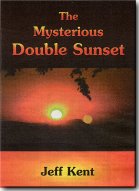Review of ‘The Mysterious Double Sunset’, by Jeff KentThis review is by Julie Bunting, and was published originally in The Peak Advertiser, the Peak District's local free newspaper, on 1st July 2002, and is reproduced with Julie's kind permission.
A simple description of the phenomenon tells us that 'the sun sets twice in the same evening at a certain time of the year ...', this being around the time of the summer solstice. The double sunset has been part of the author's life for 30 years, in spite of the fact that 17 pilgrimages were made in vain before he saw it for himself. The traditional observation point used to be St Edward's churchyard in Leek but over the centuries the 'viewing window' has changed - in fact it has been scanning slowly north-east since the Iron Age. For some years the rare sight apparently went missing. The annual non-occurrence was variously blamed on industrial pollution, cloud, mist and overgrown trees. Jeff Kent explains how the mystery has been solved, supporting his findings with a wealth of photographs, many in colour. While he takes the trouble to explain the double sunset and the effects of time in layman's terms, he also looks at the astronomical and geological factors which produce this fascinating occurrence. Better still, he tells the reader where to go to see it, as well as providing data on other solar events which he has witnessed - including two quintuple sunsets! - from locations in Staffordshire, Cheshire and Derbyshire. That the double sunset still occurs is happily confirmed again this year. On the evenings of 20/22 June, upwards of 200 spectators gathered at Glutton Bridge, just south-west of Earl Sterndale, to watch the sun go down in unusual fashion behind Chrome Hill. And it is still not too late for you to see the extraordinary double sunset this year. Weather permitting, the event can be seen from the Glutton Bridge location for a few more days following distribution of this issue of the Peak Advertiser. Details are given in the book on how to work out the position and a simple diagram (page 200) shows the best place to stand, though in early July it will be necessary to move a short distance to the right. Review by Julie Bunting |
|||
